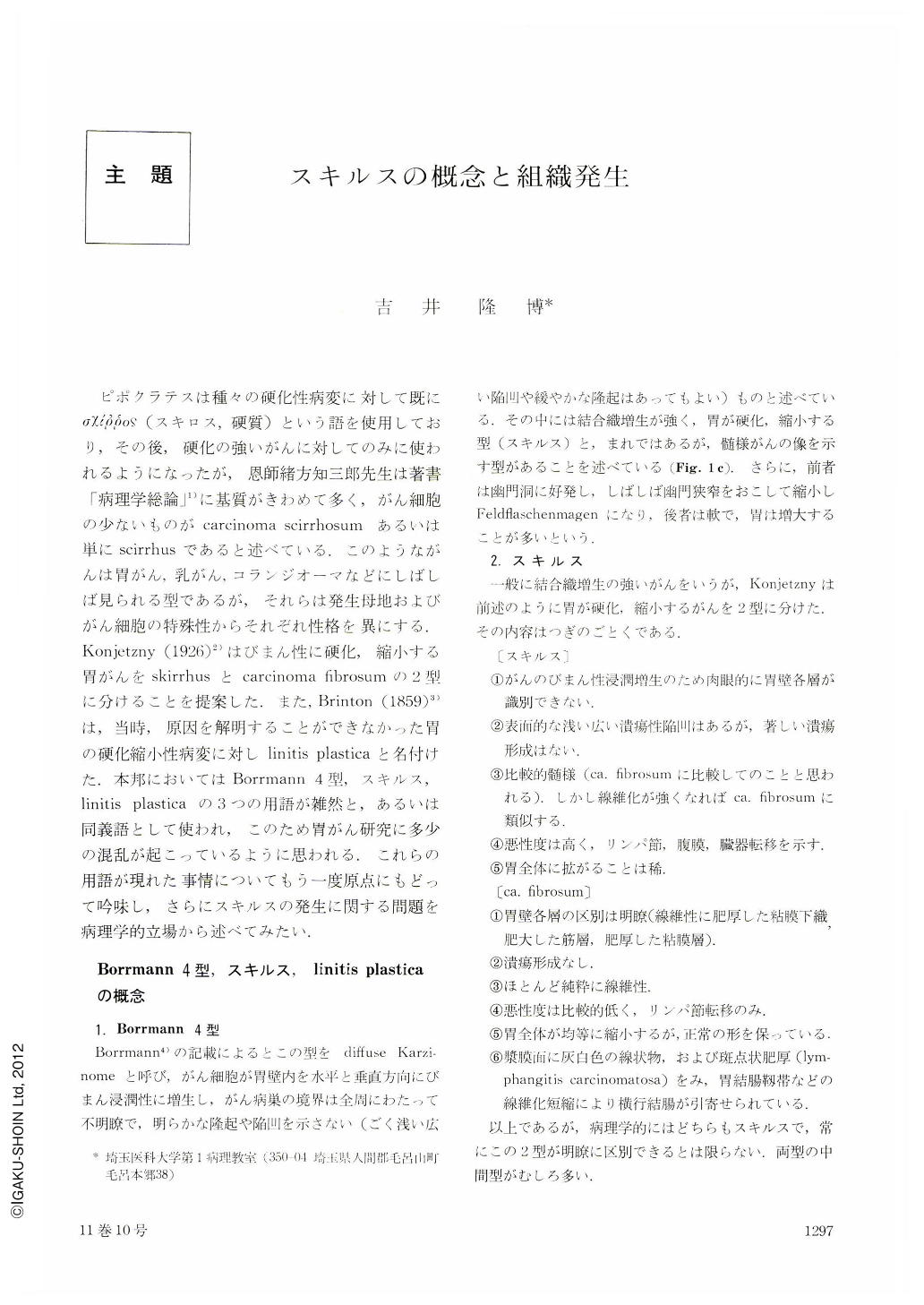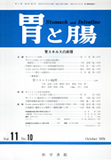Japanese
English
- 有料閲覧
- Abstract 文献概要
- 1ページ目 Look Inside
- サイト内被引用 Cited by
ピポクラテスは種々の硬化性病変に対して既にスキロス(硬質)という語を使用しており,その後,硬化の強いがんに対してのみに使われるようになったが,恩師緒方知三郎先生は著書「病理学総論」1)に基質がきわめて多く,がん細胞の少ないものがcarcinoma scirrhosumあるいは単にscirrhusであると述べている.このようながんは胃がん,乳がん,コランジオーマなどにしばしば見られる型であるが,それらは発生母地およびがん細胞の特殊性からそれぞれ性格を異にする.Konjetzny(1926)2)はびまん性に硬化,縮小する胃がんをskirrhusとcarcinoma fibrosumの2型に分けることを提案した.また,Brinton(1859)3)は,当時,原因を解明することができなかった胃の硬化縮小性病変に対しlinitis plasticaと名付けた.本邦においてはBorrmann 4型,スキルス,linitis plasticaの3つの用語が雑然と,あるいは同義語として使われ,このため胃がん研究に多少の混乱が起こっているように思われる.これらの用語が現れた事情についてもう一度原点にもどって吟味し,さらにスキルスの発生に関する問題を病理学的立場から述べてみたい.
Three technical terms, Borrmann type 4 (diffuse carcinoma), scirrhus and linitis plastica, are often regarded as synonyms. The author, however, from the following facts, would like to maintain that these three terms have each different concept and should not be used as synonyms. Borrmann (1926) described that there are two types in diffuse carcinoma; i.e., 1) scirrhous type which often forms pyloric stenosis and/or leather bottle appearance and 2) medullary or gelatinous type which often exhibits an increased size and soft consistency. Scirrhus means the carcinoma composed of a relatively small amount of carcinoma cells and the abundant fibrous stromal tissue and may represent not only Borrmann type 4, but also Borrmann type 3 and others. Linitis plastica is considered as a specific type of Borrmann 4 type scirrhus, which is often difficult to differentiate from inflammatory granulomatous disease. Namely, it is characterized by 1) leather-bottle-like stomach with clearly defined mucosal, and submucosal layer, proper muscle coat and subserosal layer, 2) a relatively smallsized and hardly recognizable primary, and submucosal lesion in the mucosa, and 3) carcinoma cells which are embedded in the dense fibrous stromal tissue and hardly discriminated from the stromal cells and inflammatory cells.
As to histogenesis, scirrhus is formed by free-cell-type carcinoma in the following mechanisms. 1) Infiltrative growth and dispersion of carcinoma cells in a mechanically low-resistant layer and space of gastric wall (mainly submucosa) by active movement such as ameboid motility and passive movement such as peristalsis or continuous proliferation. 2) Activation of the stromal cells due to mechanical, biological (such as metabolic products, toxic substances and enzyms) and immunological effects of tumor cells, followed by considerable increase in amount of stromal ground substance (proteoglycan, tropocollagen and microfibrils), and then by dense fibrosis.
Retrospective observation by X-ray and endoscopy often exhibited that there were frequent cases of Borrman 4 type scirrhus formed in a considerably short period of time. This could be explained by a hypothesis that infiltrative growth and dispersion of freed carcinoma cells throughout the stomach is unexpectedly fast.

Copyright © 1976, Igaku-Shoin Ltd. All rights reserved.


